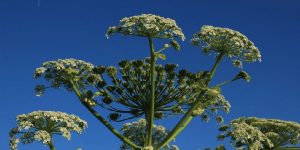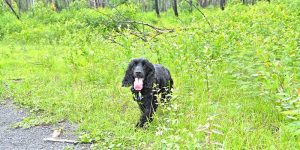The Dangers of Walking Your Dog Near Giant Hogweed.
Giant hogweed grows prolifically in the wild throughout the UK, but many people are unaware of the dangers it can pose to humans and animals. In this Holidays4Dogs article, we provide some information on this gigantic plant; including how to spot it and signs and symptoms of hogweed poisoning in dogs. If you are wondering why giant hogweed is dangerous to dogs – read on.
Giant hogweed is an impressive looking plant. It looks very similar to cow parsley – but much bigger – and many people assume it is harmless. However, Giant hogweed can be harmful due to the chemical called furocoumarin, which is present in the plant’s sap.
If hogweed sap gets onto skin it can cause phytophotodermatitis, or photosensitivity. This means the skin can become very sensitive to sunlight after contact with the sap of hogweed and causes blistering, burning and scarring.
Worse still, if the sap comes into contact with an animal’s eyes, it can lead to blindness. Since dogs tend to push through undergrowth, there is real danger of them suffering from hogweed poisoning by close contact with the plant.
What does giant hogweed look like?
Giant hogweed is often mistaken for cow parsley.  However, while cow parsley is a more delicate plant, giant hogweed can grow up to 5 meters tall.
However, while cow parsley is a more delicate plant, giant hogweed can grow up to 5 meters tall.
The stems are green but they often have purple patches. Spikey white hairs cover the hollow stems, the base of each leaf stalk and the underside of the leaf.
The leaves can be enormous – up to 1.5 meters wide and 3 meters long. The leaves resemble those found on rhubarb plants.
The plant flowers in the months of June and July. The flowers are, again, very similar in appearance to cow parsley.
A mass of small white petals are supported on an umbrella-like stem frame. These flower heads can be up to 60 cm in diameter, all facing towards the sky.
Where does giant hogweed grow?
Giant hogweed grows readily all over the UK, but is commonly found alongside riverbanks. The growing season for hogweed is between spring and autumn. Giant hogweed plants can produce as many as 50,000 seeds per year and can rapidly smother native species of plants.
This humungous plant is not native to the UK, but originates from Central Asia. Giant hogweed was brought to the UK in the 19th Century as an ornamental plant. With it’s sculptural qualities and impressive appearance, it’s attraction can be understood.
However, once naturalized in the wild, it is classed as an invasive species and is considered by many local authorities to be a public health hazard.
How can giant hogweed affect my dog?
The most dangerous aspect of giant hogweed is the sap. If a dog (or person) comes into contact with the sap from giant hogweed is can result in severe photosensitivity to sunlight. It may only take a person – or animal – to touch, or brush against the plant, resulting in exposure to the sap.
to sunlight. It may only take a person – or animal – to touch, or brush against the plant, resulting in exposure to the sap.
Symptoms may not appear until a few days after contact with the sap and subsequent exposure to sunlight. Reactions can vary between individual people and animals.
It can cause severe blistering which may take a long time to heal. In many cases, scarring can occur that never completely goes away.
If the sap gets into the dog’s eyes it can cause partial, or complete blindness.
Similarly, giant hogweed also poses a danger to human health due to its toxic sap. The fact that the plant is difficult to deal with, means that attempts to eradicate it are challenging.
Symptoms of hogweed poisoning.
In the first few hours of coming into contact with hogweed sap, the skin will become blotchy and very itchy. The rash can develop into painful blisters and take a very long time to heal. Scarring can last for many years after the blisters have healed. In addition, the affected area may be sensitive to sunlight long after exposure to hogweed sap. Skin burns from hogweed sap don’t develop immediately.
Treatment for hogweed poisoning.
If you know, or suspect, your dog has come into contact with the sap from giant hogweed, it is important to wash him as soon as possible. A dog affected by hogweed may need specialist skin care.
Steroid cream and antibiotics will reduce pain and stop infection. It is likely the dog may need to wear an Elizabethan collar to prevent him from scratching damaged skin.
While the dog is recovering, it is vitally important to keep him away from direct sunlight as much as possible. A dog’s skin may be sensitive for many years to come and in some cases, phytophotodermatitis can return. It would be wise for owners to use sun cream, a protective coat and keep the dog out of the sun as much as possible over the long term.
Giant hogweed hits the news.
Giant hogweed can be particularly dangerous to children, dogs and other animals, as they are more susceptible to burns after with contact with giant hogweed. In June 2023, a Londoner was left with permanent scars after brushing past giant hogweed in Boston Manor Park.
Dubbed ‘Britain’s most dangerous plant’, giant hogweed was also discovered in a park in Leicestershire in 2022. Many local authorities, along with experts such as those from the Royal Horticultural Society and the Woodland Trust are now warning the public about the dangers of contact with giant hogweed.
Conclusion.
Giant hogweed, is definitely dangerous to people and dogs, so it is important to be vigilant. There are no laws or regulations, that state giant hogweed must be reported. However, it is useful to send recorded sightings to GB non-native species secretariat as this helps track the distribution of non-native plants (and animals). It may also be worth informing your local council, or land management teams.


